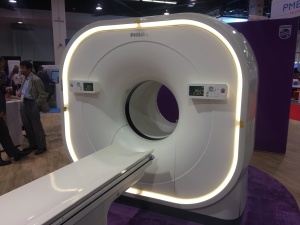by
John R. Fischer, Senior Reporter | June 25, 2019

Vereos Digital PET/CT scanner
An estimated two million PET/CT scans were performed last year in the U.S., marking the highest procedure volume ever for the modality, according to Royal Philips.
It is for that reason that the Dutch healthcare manufacturer chose the SNMMI 2019 Annual Meeting in Anaheim, California to discuss the advantages offered by digital PET/CT.
“A lot of the indications are [that] through 2022 this trend will continue to see growth in the U.S.,” Joseph Connor, international business leader at Philips, told HCB News. “I think the value of what PET imaging brings the entire healthcare industry is that we are starting to see the advantages of being able to more accurately stage patients, and that in many cases, when you see with digital imaging, you are picking up information that you hadn’t seen before with analog. You can potentially change the staging. You’re going to see the power of what that imaging is capable of doing from the physiological standpoint.”



Ad Statistics
Times Displayed: 364929
Times Visited: 6943 Quality remanufactured Certified Centrifuges at Great prices! Fully warranted and backed by a company you can trust! Call or click for a free quote today! www.Centrifugestore.com 800-457-7576
Philips is the producer of the Vereos Digital PET/CT system, the first and only fully digital scanner of its kind. Equipped with proprietary, digital photon technology, it is capable of quantifying lesion detectability by performing one-to-one coupling that provides an immediate digital signal, rather than an analog one that must be converted into a digital count.
It is this and other capabilities that makes Conner confident that the future of digital PET/CT will bring more immediate and precise diagnoses at reduced dose, faster speeds and lower cost.
“Some hospitals are doing 35 patients a day. But in many cases, they can get down to less than five minute scans on those patients. Scanning more patients a day, you can be more efficient with the staff you have on hand,” he said. “You may not have to staff as much as you did before. From the pharmaceutical point of view, if you can reduce the amount of dose you are applying, then you can reduce the amount of cost your hospital has to pay operationally. I think there are a lot of advantages both on the patient and speed aspect, as well as on the dose operational expense for it.”
He adds that the growing digital modality has prospects for not just cancer care but that of the heart and neurological state too.“There is more opportunity in oncology but also in other fields of neurology and cardiology. The promise of cardiology and seeing the advancement of that could be pretty rapid. Neurology we’ve seen continuing to drive Alzheimer’s [advances] or drugs that could treat it. I think that could be an area in which the number of PET imaging procedures will continue to grow.”
Back to HCB News

